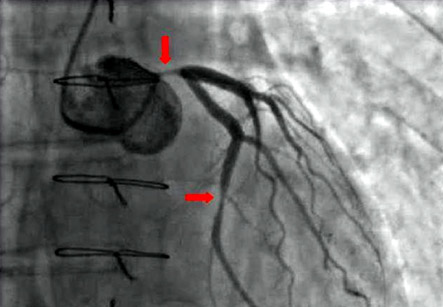Coronary Catheterization
Introduction
A coronary catheterization is a minimally invasive procedure to access the coronary circulation and blood filled chambers of the heart using a catheter. It can be performed for both diagnostic as well as therapeutic purposes.
Coronary catheterization is one of the important cardiology diagnostic tests and procedures. This procedure is specifically performed to recognize occlusion, stenosis, re-stenosis, thrombosis or aneurysmal enlargement of the coronary arteries. It can also determine heart chamber size, heart muscle contraction and some aspects of heart valve function. Important heart and lung blood pressures can be accurately measured during the test. The usual primary purpose of the test is evaluating problems which occur as a result of advanced atherosclerosis. This can cause formation atheroma within the wall of the coronary arteries leading to narrowing of the lumen of artery. Less frequently, valvular, heart muscle, or arrhythmia are the primary focus of the test.
Coronary catheterization has a slightly higher risk than other heart tests. But in hands of experienced cardiology team, it is safe.
Iran is among the top 10 countries in treating cardiovascular diseases, while it ranks first in the Middle East

Coronary artery luminal narrowing reduces the availability of oxygenated blood to the heart, resulting in pain syndrome known as intermittent angina. Very advanced luminal occlusion usually results in death of a cardiac tissue in that area and heart attack.
If patient is already having coronary artery disease, this test can determine whether a surgery or other intervention such as angioplasty and stenting will be required to open the blocked vessel.
Coronary catheterization can check the results of coronary intervention and it can also help in early detection of restenosis.
Preparation:
1. A proper history, examination and few lab tests are done to determine the general health. 2D echo, ECG and X-ray chest are done as a part of evaluation of cardiac disease
2. Patient should stop anti-inflammatory drugs like aspirin at least a week before surgery
3. Medications being taken for other conditions like diabetes, heart disease, blood pressure should be continued with advice from the treating doctor
4. History of smoking or alcohol drinking should be told to the surgeon
5. Recent history of cough, cold, fever, viral infections, or other illnesses should be informed
6. Any allergy to medications or sea food should be informed
7. Past reaction to any contrast dye or iodine contrasts should be informed
8. Any medications for erectile dysfunction being taken should be told
9. Possibility of pregnancy should be ruled out
10. Presence of kidney disease should be informed to the doctor as the contrast agent used for the procedure can damage the kidney
Before the Test:
Patient is advised not to eat or drink for 6 – 8 hours before the test. Make sure to ask the cardiologist about the entire procedure, steps involved and risks of the same. A written, informed, signed consent of the patient for the procedure is obligatory.
Procedure:
1. Medications for allaying anxiety are given before the test to make the patient relax. Patient is awake throughout the procedure and can follow the commands. Pediatric patients may need a strong sedative
2. The cardiologist or surgeon cleans the site of puncture on the arm, neck or groin and inserts a line in a vein at that site. This is the intravenous (IV) line. The patient can have some discomfort when the lines or catheters are inserted
3. A sheath or a larger plastic thin tube is then inserted in a vein or artery depending on the procedure in the arm or leg
4. After this, longer plastic tubes called catheters can be moved into the heart upward under continuous fluoroscopic guidance
Then, the surgeon can:
• Measure pressures and flows in various heart chambers and in the large vessels of the heart
• Measure the oxygen saturation in different heart chambers
• Collect blood samples from heart
• Take heart muscle biopsy
• Examine the arteries for any abnormality
1. If there is a block in coronary arteries, definitive angioplasty and stenting can be done.
2. The test takes about 30 to 60 minutes or longer depending on whether any special procedure is to be done. The catheter is removed after the procedure and pressure is maintained on the point of insertion for at least 10 to 15 minutes to prevent bleeding.
3. Patient can go home or is admitted in hospital depending on the procedure.
Risks:
Coronary catheterization has a slightly higher risk than other heart tests. But in hands of experienced cardiology team, it is safe.
The risks are:
1. Irregular heartbeat
2. Sudden lowering of blood pressure
3. Reaction to the contrast dye used.
4. Cardiac temponade
5. Heart attack on table
6. Stroke risk
Possible complications of any type of invasive catheterization are:
1. Bleeding
2. Infection
3. Injury to blood vessels
4. Blood clots
5. Kidney damage as a side effect of contrast dye. Patients with diabetes or existing kidney disease are predisposed to this condition